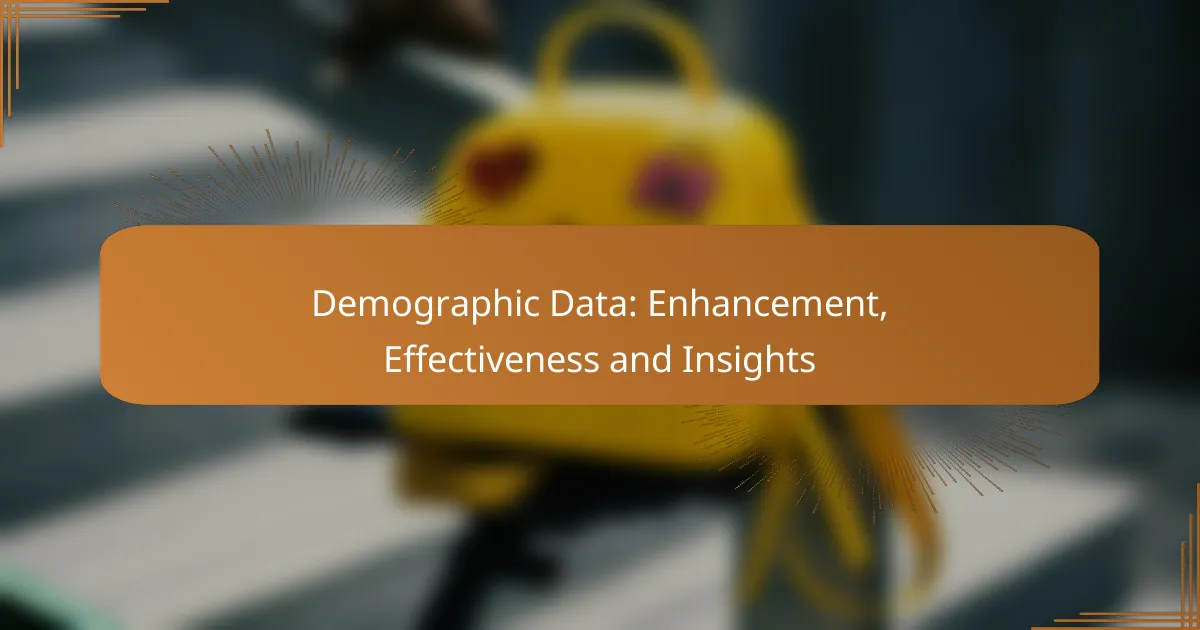Identifying an ideal customer profile (ICP) is crucial for businesses looking to optimize their marketing efforts and enhance engagement through targeted advertising. By understanding the traits and behaviors of their most valuable customers, companies can tailor their strategies to meet specific needs, ultimately driving growth and improving outcomes. Implementing effective strategies such as customer personas and data analysis can significantly aid in this identification process.

How to identify an ideal customer profile in display advertising?
Identifying an ideal customer profile (ICP) in display advertising involves understanding the characteristics and behaviors of your most valuable customers. This process helps tailor advertising strategies to effectively reach and engage the right audience.
Demographic analysis
Demographic analysis focuses on the statistical characteristics of your target audience, such as age, gender, income level, education, and geographic location. By examining these factors, you can create a clearer picture of who your ideal customers are.
For instance, if your product appeals primarily to young professionals in urban areas, your advertising efforts should target those demographics specifically. Tools like surveys and census data can provide valuable insights into these demographics.
Behavioral segmentation
Behavioral segmentation divides your audience based on their interactions with your brand, including purchasing habits, product usage, and engagement levels. Understanding these behaviors allows you to tailor your messaging and offers to meet their specific needs.
For example, if you notice that a segment of your audience frequently engages with your content but rarely makes a purchase, you might consider offering them exclusive discounts to encourage conversion.
Market research techniques
Market research techniques involve gathering data about your target market through various methods such as surveys, focus groups, and competitor analysis. These techniques help identify trends and preferences that inform your ICP.
Utilizing online survey tools can streamline this process, allowing you to reach a broader audience quickly. Aim to gather qualitative and quantitative data to create a comprehensive view of your ideal customers.
Customer interviews
Conducting customer interviews provides direct insights into the thoughts and motivations of your existing customers. These conversations can reveal what they value most about your product or service and what challenges they face.
Prepare open-ended questions that encourage detailed responses. This qualitative feedback can enhance your understanding of customer needs and help refine your ICP.
Data analytics tools
Data analytics tools help analyze customer data to identify patterns and trends that define your ideal customer profile. These tools can track user behavior, engagement metrics, and conversion rates, providing actionable insights.
Consider using platforms like Google Analytics or customer relationship management (CRM) systems to gather and analyze this data. Regularly reviewing analytics can help you adjust your advertising strategies to better align with your ICP.

What are the benefits of defining an ideal customer profile?
Defining an ideal customer profile (ICP) helps businesses focus their marketing efforts on the most valuable customers, leading to more effective strategies and improved outcomes. By understanding who their best customers are, companies can tailor their products and services to meet specific needs, ultimately driving growth.
Improved targeting accuracy
With a well-defined ICP, businesses can enhance their targeting accuracy by identifying the characteristics that make up their best customers. This allows for more precise marketing campaigns that reach individuals who are more likely to convert, rather than casting a wide net that may attract less relevant prospects.
For example, if a company finds that its ideal customers are primarily small business owners in the tech industry, it can focus its advertising efforts on platforms frequented by this demographic, such as LinkedIn or industry-specific forums.
Enhanced ad performance
When marketing efforts align with an ICP, ad performance typically improves. Ads that resonate with the target audience are more likely to generate clicks and engagement, leading to higher conversion rates. This is because the messaging and visuals can be tailored to appeal directly to the identified customer traits.
Utilizing data analytics tools can help track ad performance metrics, allowing businesses to refine their campaigns based on what works best for their ideal customers. A/B testing different ad formats can also reveal which messages resonate most effectively.
Increased ROI
Defining an ICP can lead to increased return on investment (ROI) by ensuring that marketing budgets are spent on strategies that yield the highest returns. By focusing on the most promising customer segments, businesses can reduce wasted spending on less effective outreach.
For instance, companies that target their ads based on their ICP often see a significant uptick in sales, sometimes achieving ROI improvements of 30% or more. This strategic allocation of resources allows for better financial planning and growth opportunities.
Better customer retention
Understanding the ideal customer profile not only aids in attracting new customers but also plays a crucial role in retaining existing ones. By catering to the specific needs and preferences of ideal customers, businesses can foster loyalty and long-term relationships.
Implementing feedback mechanisms, such as surveys or customer interviews, can provide insights into what keeps these customers satisfied. Companies can then adjust their offerings or customer service approaches accordingly to enhance retention rates.

What strategies can be used to create an ideal customer profile?
Creating an ideal customer profile involves several strategies that help identify and understand the characteristics of your best customers. These strategies include utilizing customer personas, leveraging CRM data, conducting competitive analysis, and implementing A/B testing.
Utilizing customer personas
Customer personas are fictional representations of your ideal customers based on data and insights. They help in visualizing customer needs, preferences, and behaviors, making it easier to tailor marketing strategies. To create effective personas, gather demographic information, psychographics, and buying patterns from existing customers.
Consider segmenting personas based on factors such as age, income, location, and interests. This segmentation allows for more targeted marketing efforts, ensuring that your messaging resonates with each group.
Leveraging CRM data
Customer Relationship Management (CRM) systems store valuable data about customer interactions and transactions. Analyzing this data can reveal patterns that help identify your ideal customer profile. Look for trends in purchase frequency, average order value, and customer lifetime value to understand which segments contribute most to your business.
Ensure your CRM is updated regularly to maintain accurate data. This will enable you to refine your ideal customer profile over time as new insights emerge from ongoing customer interactions.
Conducting competitive analysis
Competitive analysis involves studying your competitors to understand their customer base and market positioning. By analyzing their strengths and weaknesses, you can identify gaps in the market that your ideal customer might fill. Look at their customer reviews, social media engagement, and marketing strategies to gain insights into what appeals to similar audiences.
Utilize tools like SWOT analysis (Strengths, Weaknesses, Opportunities, Threats) to systematically evaluate competitors. This will help you refine your ideal customer profile by understanding what attracts customers to your competitors and how you can differentiate your offerings.
Implementing A/B testing
A/B testing allows you to compare two versions of a marketing element to see which performs better. This can be applied to various aspects such as email campaigns, landing pages, or ad copy. By testing different approaches, you can gather data on what resonates with your target audience and refine your ideal customer profile accordingly.
When conducting A/B tests, ensure that you have a clear hypothesis and measurable goals. Analyze the results to understand customer preferences and adjust your strategies to better align with your ideal customer profile.

What tools assist in developing an ideal customer profile?
Several tools can help businesses create an ideal customer profile by analyzing customer data, behavior, and demographics. These tools provide insights that enable companies to better target their marketing efforts and improve customer engagement.
HubSpot
HubSpot offers a comprehensive platform that includes CRM, marketing, and sales tools to help identify and refine your ideal customer profile. Its analytics features allow you to track customer interactions and segment your audience based on various criteria, such as behavior and demographics.
Utilizing HubSpot’s reporting tools, businesses can visualize customer data and identify trends that inform their ideal customer profile. This can lead to more effective marketing strategies and improved customer retention.
Google Analytics
Google Analytics is a powerful tool for understanding website traffic and user behavior, making it essential for developing an ideal customer profile. By analyzing metrics such as user demographics, interests, and behavior flow, businesses can gain insights into who their customers are and what they want.
To effectively use Google Analytics, set up goals and conversion tracking to see which audience segments are most valuable. This data can help refine marketing strategies and target efforts towards the most promising customer profiles.
SEMrush
SEMrush is primarily known for its SEO and competitive analysis capabilities, but it also offers features that aid in developing an ideal customer profile. By analyzing competitor strategies and keyword performance, businesses can identify potential customer interests and behaviors.
Use SEMrush to gather data on market trends and audience insights, which can help shape your ideal customer profile. This information can guide content creation and marketing campaigns to attract the right customers.
Facebook Audience Insights
Facebook Audience Insights provides valuable data about your audience on the platform, helping to refine your ideal customer profile. It offers demographic information, interests, and behaviors of users, allowing businesses to understand their target audience better.
To leverage Facebook Audience Insights, analyze the data to create targeted ads and content that resonate with your ideal customers. This tool can significantly enhance your social media marketing efforts by ensuring you reach the right people.

How does an ideal customer profile impact display advertising campaigns?
An ideal customer profile (ICP) significantly enhances display advertising campaigns by ensuring that ads are targeted towards the most relevant audience. By identifying the characteristics of your best customers, you can tailor your advertising efforts to reach individuals who are more likely to convert, thus maximizing your return on investment.
Increased ad relevance
When your display ads align with the preferences and behaviors of your ideal customer profile, the relevance of your ads increases. This means that the content, visuals, and messaging resonate more with your target audience, making them more likely to notice and engage with your ads.
To achieve this, analyze your ICP’s demographics, interests, and purchasing habits. For instance, if your ideal customer is a tech-savvy millennial, using modern design and tech-related language in your ads can enhance their appeal. This targeted approach can lead to higher click-through rates and better overall campaign performance.
Higher engagement rates
Higher engagement rates are a direct benefit of using an ideal customer profile in your display advertising. When ads are tailored to the needs and preferences of your target audience, they are more likely to interact with them, whether through clicks, shares, or comments.
Consider using A/B testing to refine your ad creatives based on your ICP. For example, if one version of an ad appeals more to your ideal customers, you can allocate more budget to that variant. This strategy not only improves engagement but also optimizes your advertising spend, ensuring that you are investing in the most effective ads.


